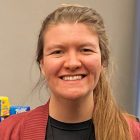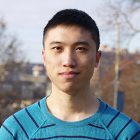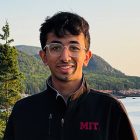Antonio Gabino Salazar Martín is a PhD candidate who seeks to advance the development of new biomedical therapeutics. As a MathWorks Fellow, Antonio is pursuing cutting-edge work on the modeling and analysis of vascular disease. His current research explores how loss of endothelial cell (EC) plasticity could become an early marker of vascular disease and a predictor of adverse outcomes to stress. This work is critical to understanding the high variability in drug responsiveness among target lesions, organs, and patients, and Antonio uses MATLAB to study how local architecture and flow states define pharmacology response. His project goals include: elucidating how pathophysiological stimuli commit ECs to reactive programs that reduce EC plasticity and multipotency in the event of vessel injury. Next, he will study circulating ECs isolated from patients, with the hope of mapping unique cellular fingerprints based on patient and pathology data, and potentially employ them as early biomarkers and predictors of cardiovascular diseases. Antonio’s work aims to change the way that vascular disease is modeled and analyzed, and his findings may lead to major improvements in cardiovascular disease detection and treatment, as well as advances in next-generation medical devices.
https://engineering.mit.edu/wp-content/uploads/2023/02/Salazar-Martín-Antonio-Gabino_Mathworks-2022.jpg
Website
Antonio Gabino Salazar Martín
Institute for Medical Engineering and Science https://engineering.mit.edu/fellows/antonio-gabino-salazar-martin/Brooke McGoldrick is a PhD candidate working at the frontier of neuromorphic computing, an emergent field that seeks to build new computing architectures that offer major advantages over traditional, electronic hardware. Specifically, Brooke is studying devices called magnetic tunnel junctions (MTJs), with the goal of demonstrating that MTJ-based nano-oscillators are good candidates for building a computing architecture called an Ising machine, which is created to solve combinatorial optimization problems that remain unsolvable on traditional electronic computers. Brooke has already established a solid foundation for understanding these systems and has demonstrated that they can be orders of magnitude faster, smaller, and more energy-efficient than previous architectures. Her MathWorks Fellowship will allow her to expand this successful work, using her novel compact model of an MTJ in circuit-level simulations and fabricating MTJs in order to physically realize the Ising machine. MATLAB powers Brooke’s innovative work from theory and simulation to experimentation and fabrication. Her open-source tools will be of great utility to other researchers, and her research holds the potential to revolutionize neuromorphic computing.
https://engineering.mit.edu/wp-content/uploads/2023/02/McGoldrick-Brooke_MathWorks-2022.jpg
Website
Brooke McGoldrick
Electrical Engineering and Computer Science https://engineering.mit.edu/fellows/brooke-mcgoldrick/Keegan L. Mendez is a PhD candidate whose research integrates biomedical and mechanical engineering approaches with clinical care to improve patient outcomes. In her current work, Keegan is developing an innovative risk assessment tool for patients with atherosclerotic cardiovascular disease (ASCVD). A MathWorks Fellowship will support Keegan as she refines this powerful tool using additional physician and patient input and works toward her longer-term goal of testing it in a clinical study. At the heart of Keegan’s work are custom MATLAB functions that deliver personalized, easy-to-understand visual information on current and future risks, including estimated impacts of specific therapy and/or lifestyle interventions and/or modifications (based on American College of Cardiology recommendations). Keegan’s work has the potential to turn complex data into user-centered tools that enable patients to better understand ASCVD risk and to work with care providers on setting treatment goals and working toward improving their health.
https://engineering.mit.edu/wp-content/uploads/2023/02/Mendez-Keegan_Mathworks-2022.jpg
Website
Keegan L. Mendez
Institute for Medical Engineering and Science https://engineering.mit.edu/fellows/keegan-l-mendez/Andreas Mentzelopoulos is a PhD candidate whose research centers on novel applications of machine-learning (ML) techniques to experimental fluid mechanics. Specifically, Andreas studies vortex-induced vibrations (VIV), a canonical engineering problem of great interest to theoreticians because of the complexity of underlying mechanisms and to engineers because of the catastrophic failures that VIVs can cause to marine structures. With the support of a MathWorks Fellowship, Andreas will pursue novel computational approaches to understanding VIV, with the goal of developing ML methods, driven by powerful, efficient algorithms, to blend experimental simulation and field data to represent the forces and responses. Andreas utilizes a combination of externally gathered data and data collected in-house at the MIT towing tank and is building an extensive repository and database for VIV data (30 TB and growing), which is already attracting interest and contributions from a global community of theoreticians and engineers working on flow-structure interaction problems.
https://engineering.mit.edu/wp-content/uploads/2023/02/Mentzelopoulos-Andreas_MechE_MathWorks-2022.jpg
Website
Andreas Mentzelopoulos
Mechanical Engineering https://engineering.mit.edu/fellows/andreas-mentzelopoulos/Thanh Nguyen is a PhD candidate working at the frontiers of quantum materials research and topological quantum computation. Specifically, Thanh studies neutron scattering on topological semimetals, an emerging branch of physics of significant importance to microelectronics, energy conversions, and quantum computing. With the support of his MathWorks Fellowship, Thanh will expand several innovative projects that explore the functional behaviors in topological materials through experimental, theoretical, and computational approaches. His goal is to develop novel mechanisms to apply topological materials in the form of heterostructures, nanostructures, or freestanding membranes, which have great potential value for next-generation technologies. MATLAB tools that Thanh has utilized, enhanced, or created are critical in the tasks of analyzing extremely large experimental data sets, simulating theoretical models, and implementing deep learning algorithms to extract further information. Thanh’s research is yielding important contributions in theory and practical applications and building on MathWorks resources and tools that support leading research on neutron scattering, quantum materials, and more.
https://engineering.mit.edu/wp-content/uploads/2023/02/Nguyen-Thanh_Mathworks-2022.jpg
Website
Thanh Nguyen
Nuclear Science and Engineering https://engineering.mit.edu/fellows/thanh-nguyen/Amin Heyrani Nobari is a PhD candidate whose research focuses on the development of novel machine-learning (ML) models and methods for automating CAD generation. His current work aims to develop generative adversarial networks (GANs) for design generation and conditional GANs for inverse design problems. Promising results of Amin’s research to date include a new GAN- based inverse design synthesis method named PcDGAN, which outperformed state-of-the-art machine-learning methods by 69%, and a novel algorithm for generating creative designs called CreativeGAN. As a MathWorks Fellow, Amin will continue to pursue new approaches in inverse design of linkage mechanisms and methods that enable algorithms to propose 2-D planar linkage mechanism designs for any given target. To enable his graph neural network ML models, Amin has developed a 10x faster algorithm to simulate mechanisms, and he publicly released a dataset of 100 million mechanisms—a resource that could be extremely valuable for researchers working on large-scale, deep learning-based linkage mechanism design.
https://engineering.mit.edu/wp-content/uploads/2023/02/Nobari-Amin_MechE_MathWorks-2022.jpg
Website
Amin Heyrani Nobari
Mechanical Engineering https://engineering.mit.edu/fellows/amin-heyrani-nobari/Crystal E. Owens is a PhD candidate whose research is focused on rheology and advancing our understanding of fluid-solid interactions to create useful new processes and tools. With the support of her second MathWorks Fellowship, Crystal will continue her work to develop rheological measurement tools for a class of non-Newtonian materials known as yield stress fluids. These materials include 3-D printing inks, biomaterials key for tissue engineering, and geofluids such as soil and lava; their physical properties make these materials extremely challenging to measure. Crystal’s research makes extensive use of MATLAB to select optimal tool geometries for real-world design and testing. She is currently working with multiple collaborators to characterize new flowable consumer products, such as ceramic slurries and delicate foams, and she has founded a small company, Rheo3D, to test commercial applications of her designs. At the same time, Crystal continues to leverage MATLAB to build new, open-source tools, such as a low-cost rheometer and a soft glassy rheology model for yield stress fluids, with the potential to advance research and education in rheology, and more broadly in materials science.
https://engineering.mit.edu/wp-content/uploads/2023/02/Owens-Crystal_MechE_MathWorks-2022.jpg
Website
Crystal E. Owens
Mechanical Engineering https://engineering.mit.edu/fellows/crystal-e-owens/Sarath Pattathil is a PhD candidate exploring multiagent learning. This area of research is becoming increasingly more important as artificial-intelligence (AI) technologies are deployed in large-scale societal applications such as transportation, healthcare, and social networks. As a MathWorks Fellow, Sarath seeks to advance dynamic interactions between humans and AI-driven systems and between multiple AI-driven agents. MATLAB is a vital tool in his work, enabling Sarath to design robust models and to achieve optimal system control. Specifically, his research has three focus areas. The first is the study of robustness of multiagent systems to adversarial perturbations, particularly the non-asymptotic analysis of gradient-based algorithms, including the proximal point, extragradient, and optimistic gradient descent ascent methods. The second is exploring control and intervention in the presence of spreading processes among agents, specifically for epidemic modeling and control. Finally, the third is exploring learning in multiagent systems and examining which network architectures enable robust learning, what factors determine that strength, and how it can be replicated and leveraged in future applications.
https://engineering.mit.edu/wp-content/uploads/2023/02/Pattathil-Sarath_Mathworks-2022.jpg
Website
Sarath Pattathil
Electrical Engineering and Computer Science https://engineering.mit.edu/fellows/sarath-pattathil/Colin Pavan is a PhD candidate whose research focuses on nonthermal plasma (NTP) technologies, which hold significant promise as flexible, scalable, environmentally sound energy sources. Specifically, Colin’s research aims to create new NTP technologies to address needs in clean combustion and low emissions, economically viable sustainable fuel production, CO2 conversion, and more. As a MathWorks Fellow, he will explore a key, yet under-researched, aspect of plasma assisted combustion (PAC), the two-way coupling of plasma and flame. MATLAB plays a central role in Colin’s research, supporting all his experimental work postprocessing, as well as some of his theoretical and numerical work. MATLAB has been especially useful for determining discharge energy deposition, a key parameter in NTP strategies. Colin’s research in plasma evolution over the timescale of transient combustion fills a crucial gap in PAC studies and could help to advance PAC from the laboratory to engineering design applications, and powerful, real-world technologies.
https://engineering.mit.edu/wp-content/uploads/2023/02/Pavan-Colin_MathWorks-2022.jpg
Website
Colin Pavan
Aeronautics and Astronautics https://engineering.mit.edu/fellows/colin-pavan/Randall (Randy) Pietersen is a PhD candidate whose research is focused on the development of new deep learning (DL) tools and methods for airfield damage assessment. Specifically, Randy’s work is centered on pavement structures and the development of novel, drone-based, remote sensing technologies as a safer, faster alternative to manual, human assessment. As a MathWorks Fellow, Randy will expand his work in the use of drones and hyperspectral image interpretation in the detection and classification of pavement damage and unexploded ordnance. This project will involve creating and characterizing the performance of new convolutional neural networks (CNN) that will reliably classify hyperspectral image data in real time. Randy relies on MATLAB tools to train, test, and compare CNN models and to address the most complex problems in autonomous pavement inspection and UAV-based hyperspectral remote sensing. His work has the potential to strengthen the field of DL research and to protect lives by improving the safety and efficiency of airfield operations for the United States Air Force.
https://engineering.mit.edu/wp-content/uploads/2023/02/Pietersen-Randall_CEE_MathWorks-2022.jpg
Website
Randall Pietersen
Civil and Environmental Engineering https://engineering.mit.edu/fellows/randall-pietersen/Victor Qin is a PhD candidate whose research is centered in cutting-edge aerial technologies, including unmanned aerial vehicles (UAVs). Specifically, Victor is addressing challenges presented by UAVs and similar technologies in air traffic control. UAVs present issues that traditional air traffic control (ATC) is ill-equipped to handle, including a high volume of on-demand flights that are far from airports. As a MathWorks Fellow, Victor will develop new unmanned traffic management (UTM) systems and regulatory frameworks to coordinate UAVs and related vehicles alongside current ATC. His research explores two primary questions: What are optimal UTM strategies, and how should UTM regulatory frameworks operate? His goals include the creation of decentralized protocols for strategic planning and UAV “rules of the road” with particular focus on unmanned space systems (USS). MathWorks software is an essential tool in Victor’s work, allowing him to develop effective new mechanisms and methods that address a range of safety and logistical issues specific to USS, while maintaining competitive growth in this fast-growing industry.
https://engineering.mit.edu/wp-content/uploads/2023/02/Qin-Victor_MathWorks-2022.jpg
Website
Victor Qin
Aeronautics and Astronautics https://engineering.mit.edu/fellows/victor-qin/Madhumitha Ravichandran is a PhD candidate is interested in advancing heat transfer and sur- face engineering techniques to enhance the safety and performance of nuclear energy systems and to reduce environmental impacts. Specifically, her work is focused on new methods to in- crease boiling heat transfer limits, a key issue for the nuclear industry and other high-technology applications, such as aerospace and computer cooling. Madhumitha’s past research includes the computational modeling of boiling phenomena in nuclear reactors, which yielded new findings on bubble formation on engineered surfaces and the development of innovative AI-driven approaches to data analysis. Most recently, Madhumitha created one of the first autonomous thermal-hydraulics laboratories. With the support of her MathWorks Fellowship, she will refine this system and complete a “self-driving” experiment capable of discovering new physical phenomena and identifying autonomous heat transfer solutions. Drawing extensively on MATLAB tools Madhumitha’s work is changing experimental research in thermal science and offering new possibilities for AI applications in the field. She has also created custom tools that are valuable for thermal science and hold great potential for machine-learning research in other fields.
https://engineering.mit.edu/wp-content/uploads/2023/02/Madhumitha-Ravichandran_MathWorks-2022.jpg
Website
Madhumitha Ravichandran
Nuclear Science and Engineering https://engineering.mit.edu/fellows/madhumitha-ravichandran-2/Zhijian Ren is a PhD candidate studying microrobotics. His work centers on the creation of insect- scale flapping wing micro-aerial-vehicles (FWMAVs) with the agility and robustness of flying insects. Possible applications for FWMAVs include assisted agriculture (pollination) and search and rescue operations. As a MathWorks Fellow, Zhijian will advance an ongoing collaborative project with MathWorks to address unique challenges in microrobotics and FWMAVs in particular. Utilizing MATLAB and Simulink, he has created a state-of-the-art experimental setup that has become a foundational tool in his own work and for colleagues in his lab. He has designed custom MATLAB codes to analyze robot flapping kinematics, extract wing stroke and pitch motion, analyze robot takeoff, and calculate net lift force. Currently, Zhijian coleads a project to design and improve high-bandwidth soft actuators, and is coleading the construction of a flight arena for FWMAVs. The flight arena utilizes Simulink Real-Time, and in the future, Zhijian hopes to employ the Speedgoat Performance real-time target machine to fly multiple FWMAVs and mimic insect swarm behaviors. Zhijian’s work has already yielded new hardware and software applications, and his research has the potential to greatly advance the field of microrobotics.
https://engineering.mit.edu/wp-content/uploads/2023/02/Ren-Zhijian_Mathworks-2022.jpg
Website
Zhijian Ren
Electrical Engineering and Computer Science https://engineering.mit.edu/fellows/zhijian-ren/Kariana Andrea Moreno Sader is a PhD candidate whose research focuses on decarbonizing transportation systems, a key component in addressing climate change and developing a sustainable, global economy. Specifically, Kariana uses a combination of MATLAB-based simulation and analysis to compare options in long-haul trucking, one of the most challenging sectors of the economy to decarbonize. As a MathWorks Fellow, Kariana will advance her innovative modeling techniques to provide comparisons of different vehicle types and associated refueling/recharging infrastructure, with the goal of providing useful “apples-to-apples” comparisons and economic metrics that support decision-making. Her analysis is already yielding useful insights; for example, her work demonstrates that given current costs, a sizeable carbon tax will be needed to drive the transition to cleaner powertrains. Kariana is making extensive use of MATLAB tools in her research and sharing her own models and applications with the MathWorks community. Kariana’s work has the potential to help identify real solutions for combating climate change and offers an inspiring example of the ways that MATLAB can be deployed in the creation of innovative decision-making tools in many areas of research.
https://engineering.mit.edu/wp-content/uploads/2023/02/Moreno-Sader-Kariana_ChemE_MathWorks-2022.jpg
Website
Kariana Andrea Moreno Sader
Chemical Engineering https://engineering.mit.edu/fellows/kariana-andrea-moreno-sader/Noah Salk is a PhD candidate building complex analytic models of practical problems at the intersection of physics, mathematics, and computational modeling. Specifically, Noah’s work seeks to advance the development of a new class of resonant, electronic power transformers. MATLAB has enabled him to create powerful new models, equal to the task of solving practical problems rich in complex physics. Recent examples include models for electromagnetic processes and effects within high frequency resonant transformers and highly accurate, new methods of calculating high frequency losses in complex, winding structures. As a MathWorks Fellow, Noah will investigate loss reduction in high power, high-frequency multi-coil systems using custom MATLAB tools to implement analytical models, interface with and run simulations in an external tool, and compare those methods with experimental data. His explorations of physical phenomena and design methods for high-efficiency, high-power, coreless resonant transformers are yielding valuable new knowledge and tools to enrich his own work and the efforts of other researchers. Ultimately, Noah’s research could be a crucial next step toward the development of next-generation transformers for renewable power.
https://engineering.mit.edu/wp-content/uploads/2023/02/Salk-Noah_Mathworks-2022.jpg
Website
Noah Salk
Electrical Engineering and Computer Science https://engineering.mit.edu/fellows/noah-salk/Pedro Seber e Silva is a PhD candidate whose computational research uses the power of artificial intelligence (AI), especially machine learning (ML) and deep learning (DL), to solve problems related to biomedicine and bioproduction. Pedro has made contributions to the research community with powerful new ML and DL models that predict the glycosylation of monoclonal antibodies (mAbs), which are important biotherapeutics in the treatment of autoimmune conditions, infections, and cancer—and have the potential to treat many other diseases. With the support of a MathWorks Fellowship, Pedro will continue to build and refine his AI models, which could offer substantial improvements over existing models, and expand his work to study the Chinese hamster ovary cell lines used to produce mAbs, an area of great importance in long-term perfusion cultures now being developed to reduce costs and improve glycosylation control. Pedro’s work is already speeding the development of urgently needed biotherapeutics, and his work in computational modeling could help researchers in many fields—including non-experts in data science and programming—to leverage cutting-edge AI methods and tools in their work.
https://engineering.mit.edu/wp-content/uploads/2023/02/Seber-e-Silva-Pedro_ChemE_MathWorks-2022.jpg
Website
Pedro Seber e Silva
Chemical Engineering https://engineering.mit.edu/fellows/pedro-seber-e-silva/Arjav Shah is a PhD candidate whose research focuses on the development of sterility testing methods for cell and gene therapies for human disease. Specifically, Arjav is working on new strategies to make biomanufacturing safer through the real-time detection of adventitious agents, such as viruses, at various points in the manufacturing process. With the support of a MathWorks Fellowship, Arjav is pursuing a highly promising novel application of nanopore sensors to fingerprint viruses. The overarching goal of his project is to develop a machine-learning (ML) algorithm that identifies a biomolecule based on its ionic current signature as it is pushed through a nanopore in a freestanding membrane between two electrolyte-filled reservoirs. Arjav’s research employs a combination of multi-scale simulations and ML-driven analysis of experimental data. MATLAB is a vital tool in this work, from model formulation to evaluation and optimization. If successful, Arjav’s nanopore sensor could enhance safety and efficacy in the development of therapeutics for a broad range of diseases and reduce the time required for sterility testing from 2-4 weeks to just hours. His work is also generating innovative new MATLAB tools that are a valuable resource for the nanopore research community.
https://engineering.mit.edu/wp-content/uploads/2023/02/Shah-Arjav_ChemE_MathWorks-2022.jpg
Website
Arjav Shah
Chemical Engineering https://engineering.mit.edu/fellows/arjav-shah/Thomas J. Sheehan is a PhD candidate whose research is focused on an emerging new class of semiconductors known as halide perovskite nanomaterials. The remarkable optical properties of these materials—including near-unity quantum yields, highly tunable emission wavelength, and narrow emission line widths—make them highly promising components for next-generation solar cells, light-emitting devices, television displays, lasers, and quantum information systems. As a MathWorks Fellow, Thomas will investigate the excited state energy transport in halide perovskite quantum dots (PQDs) and PQD assemblies, using transient photoluminescence microscopy. MATLAB tools enable analysis and visualization of the resulting multidimensional data sets and help Thomas to efficiently test new hypotheses for PQD behaviors. The early results of his research are extremely promising, offering insights into the fundamental physics underlying the optical behavior of these materials. By developing a deeper understanding of PQD assemblies, Thomas’s work may be an important step forward in the development of new optoelectronic devices and quantum information systems.
https://engineering.mit.edu/wp-content/uploads/2023/02/Sheehan-Thomas_ChemE_MathWorks-2022.jpg
Website
Thomas J. Sheehan
Chemical Engineering https://engineering.mit.edu/fellows/thomas-j-sheehan/Jingnan Shi is a PhD candidate whose research is focused on perception and vision-based navigation for robots and autonomous systems with the goal of improving the safety, durability, and effectiveness of these systems. As a MathWorks Fellow, Jingnan will pursue three primary projects: development of a new algorithm to deliver fast and certifiably robust 3-D perception, a tool that has been successfully applied in several large-scale robotic systems and shared with the research community; a graph theoretic framework for outlier rejection in various geometric perception problems, offering greater speed and robustness than existing solvers; and category level perception for self-driving vehicles, involving the creation of a novel solver for estimating shapes and poses of cars surrounding an experimental robot. His plans include designing new methods to incorporate learned robustness into robotic perception systems, including the investigation of differential programming to improve robot robustness through unsupervised learning. MATLAB is key to Jingnan’s work, enabling him to bridge grounded algorithms with high-performance implementations and to make valuable contributions to the field of robotics.
https://engineering.mit.edu/wp-content/uploads/2023/02/Shi-Jingnan_MathWorks-2022.jpg
Website
Jingnan Shi
Aeronautics and Astronautics https://engineering.mit.edu/fellows/jingnan-shi/Dhyllan Skiba is a master’s candidate who is conducting pioneering research in calcium (Ca) metal anodes and electrolytes for rechargeable Ca batteries, which may offer key long-term advantages over Lithium-based batteries. Specifically, Dhyllan is working to develop new thermodynamics- based techniques to design Ca electrolytes that provide good ionic conductivity, yet also react at the electrode interface to form a new self-limiting layer with beneficial, protective properties. As a MathWorks Fellow, Dhyllan will apply an experimental technique utilized mainly in biology/ pharmaceutical research, known as isothermal titration calorimetry (ITC), for the first time in studying battery electrolytes. He has also created a MATLAB based “binding model,” inspired by biological systems. Together, ITC and the binding model will help Dhyllan to better understand and quantify Ca2+ solvation, thereby unlocking new electrolyte design principles. Dhyllan’s work promises to offer critical insights for Ca battery design, helping to meet the growing need for high energy density batteries in vehicle electrification. In addition, his model for investigating Ca2+ solvation is transferrable to almost any ligand binding phenomenon, making it a flexible tool for researchers in many areas.
https://engineering.mit.edu/wp-content/uploads/2023/02/Skiba-Dhyllan_MechE_MathWorks-2022.jpg
Website